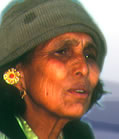THEMES IN THIS
TESTIMONY
Agriculture

Community Activities

Development

Economics

Education

Environment

Health

Justice and crime

Migration

Social Relationships

Spiritual Beliefs

Click on arrows
to find more
testimonies
featuring
these themes
|
|
Sex
|
male
|
|
|
Age
|
55
|
|
|
Identity
|
Buddhist, Tamang caste
|
|
|
Occupation
|
farmer
|
|
|
Location
|
|
|
|
Date
|
1994
|
|
summary
This interview contains interesting and detailed material on the narrator’s efforts to become literate, his involvement in traditional medicine (revealing a mixture of valuable knowledge and superstitious belief) his mediation work in the community and his successful efforts to build a school.
Of particular interest is his struggle to save the forest. The narrator gives a fascinating account of a largely single-handed campaign to stop people cutting down the saplings. He finally won the community’s support for applying rules about what should be collected or cut down. Now the forest has had the chance to grow, which has had a positive impact on local water supplies. Whereas previously there was only a small stream and partially dried-up canal, “now the rivers are full of water so we can sow our crops”. With this good supply of drinking and irrigation water, the yield is higher and people now have more food to eat. Towards the end of the interview the narrator talks about village institutions and politics and methods of solving local disputes.
detailed breakdown
|
You will need a password from Panos to view the full
transcript of the interview. To apply for a password, click here.
Once you have a password, click here to go to the beginning
of the transcript. You can also click on any section of the
breakdown of content below and go straight to the
corresponding part of the transcript.
|
| Section 1-2 |
Personal details and family history – “great-grandfather” brought cattle to graze in this area and married a local girl; family now in seventh generation. Brief discussion of Ghewa (funeral rites) and costs incurred.
|
| Section 3 |
Marriage – boy’s family looks for suitable girl, takes gifts of food and drink. Marriage age much lower than in the past owing to competition for small number of girls left in the area (reference to girl-trafficking).
|
| Section 3-5 |
Long description of his efforts to become literate and give himself more opportunities in life. Parents wanted him to be a farmer or porter but “I used to think that if I wanted I can go anywhere and do anything instead of spending my life like malei gai and jhule gai (cattle)”. Refused an arranged marriage and left home aged 14. Much hardship, various casual jobs, but eventually learned to read and write a little. Came back to village where he gradually improved his literacy skills by writing letters for others. Account of efforts to start a school, encountering corruption but persevering, taking on the teaching and construction of school buildings himself.
|
| Section 5-8 |
Adult education programme in the village and its benefits – now only five or six people who are illiterate.
Diseases – smallpox and measles now largely eradicated. High mortality in the past; now children are vaccinated. Diarrhoea and vomiting are the main ailments nowadays (not attributed to particular diseases).
Aspects of traditional medicine – when it is appropriate and when inappropriate to use animal sacrifice; reading the future by throwing rice grains; herbal remedies for specific diseases.
Doesn’t treat diarrhoea: “Instead of using the local medicines we send such cases to the hospital.”
Describes his techniques for delivery – once had to deliver his wife’s dead baby.
|
| Section 8-9 |
Agriculture; importance of organic manure. Describes how the poor used to pay loans in kind, by working moneylenders’ fields; claims loans are no longer necessary and “there is no such thing as rich and poor now.”
“Now the office has made a group in our ward and we collect 1 pathi of crop a year and Rs. 5 every month, we already have a Rs.4962 in the Melamchi Bank.”
Brief discussion on livestock
|
| Section 10-11 |
Describes how he tried to prevent local deforestation and the implications of his campaign: “from that day on the stealing has stopped. The forest had the chance to grow, so now you can see that the forest has grown everywhere.”
Says Panchayat administration failed to meet villagers’ requests for a drinking water supply scheme but ActionAid has achieved this which has meant “People have more time to cultivate the land and they can earn more.”
|
| Section 12 |
Communal labour: “System of parma is in farming - when the family cannot manage all the work, we pay others to do the job.”
Not everyone in the village has the “understanding” to send their children to school.
Talks briefly about migration in search of employment.
|
| Section 13 |
More discussion of changes – better clothes and more food nowadays: “No one is walking around without shoes now”.
Different means of settling quarrels, including use of district courts. Own role as mediator in the village.
Criticism of Panchayat system, which he claims was corrupt.
|
| Section 14-15 |
Rather confused account of being blamed for the non-election of someone as Pradhan Pancha. The loser together with other enemies of the narrator blamed the narrator for causing the death of someone’s cow – this was investigated by district authorities and narrator found not guilty. Even more confusing account of another dispute and lawsuit against him, which he eventually won. “After I won the case my life has been happy ever since.”
|
|


